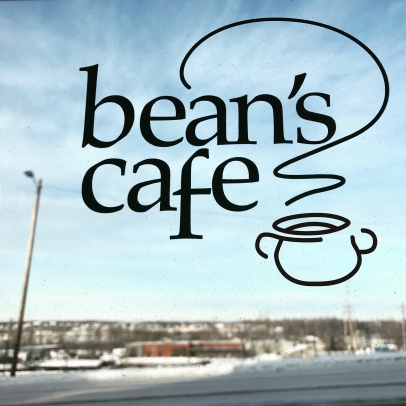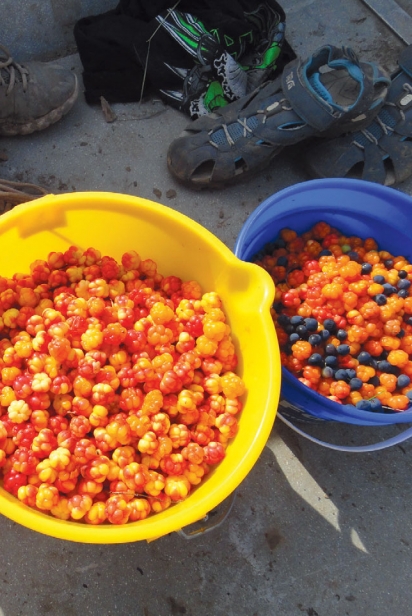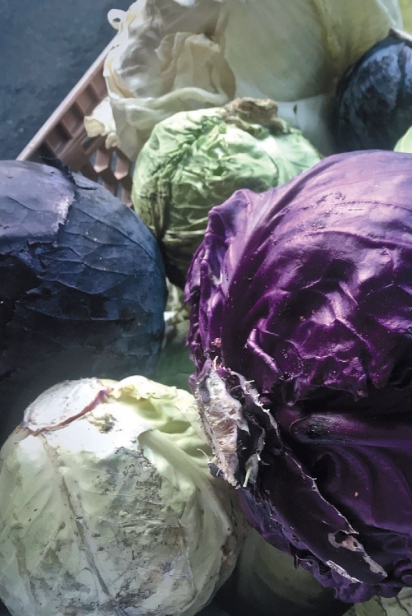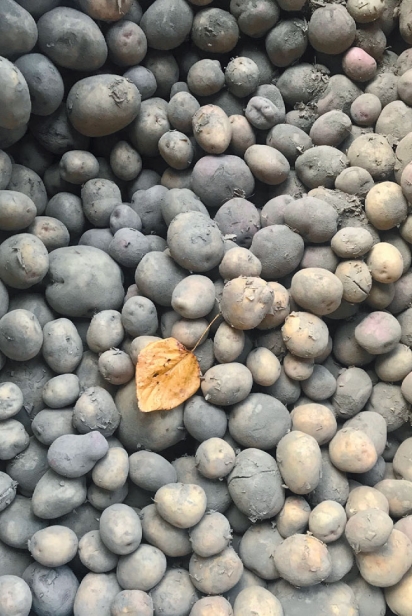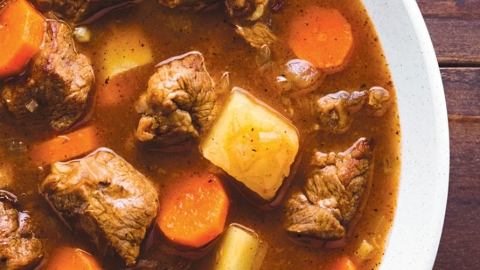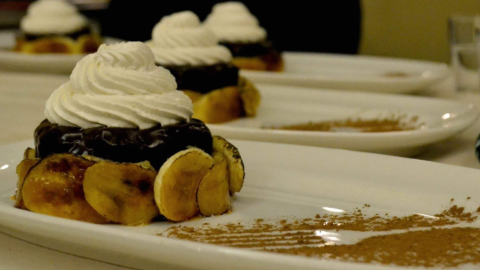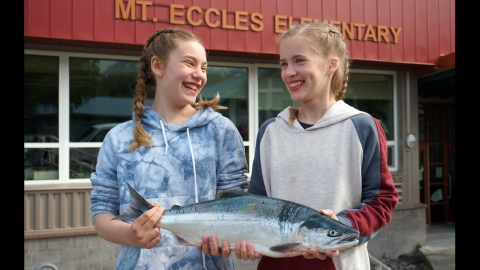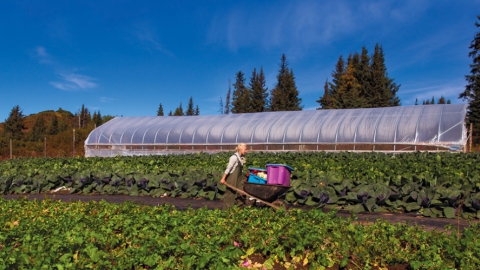Feeding the Big Village
Bean’s Café offers Alaska’s traditional flavors to Anchorage residents most in need.
A brown cauldron of thick, bubbling broth with potatoes and carrots emits steaming aromas of spices and moose. A masked Bean’s Café chef stirs the stew, which will eventually get boxed, covered, and frozen for delivery and consumption several days from now by recipients who will reheat it for warm at-home meals.
Bean’s Café is a nonprofit that has operated in Anchorage since 1979. It feeds and fights hunger and serves people of all ages. The café does much more than scoop and serve soup, and in response to the COVID-19 pandemic, it morphed to meet new needs. The café currently offers ready-made meals for pickup and they also deliver food. Production still happens at the café, though the distribution hub is now at Anchorage’s Sullivan Arena, where the city established an emergency shelter for unhoused city residents. Though sitting and eating inside the café is on hold, Bean’s still pulses with activity. Its heartbeat remains strong, steady, and even more vital during the global pandemic.
The cafe is located in downtown Anchorage, beside an empty parking lot and not far from boxy brick dive bars flying pride flags. Nearby are unused and untended, fenced plots, overgrown with weeds. Bean’s Café sits within a quadrant labeled by the United States Department of Agriculture (USDA) as a food desert. While the area has some fast food restaurants and marts, overall it lacks stores that offer a high quantity and variety of fresh produce and staples.
According to Alana Rhone, Agricultural Economist with the USDA, a food desert is an area where low income combines with low access to a supermarket, supercenter, or large grocery store. Regions with high levels of food insecurity can be urban or rural.
“A food desert is any area that does not have the accessibility for people to go out and purchase fresh, healthy, nutritious products that are afforded to people who live in areas that have those opportunities,” says Scott Lingle, Food Service Director at Bean’s Café.
Some activists in food justice find the term “food desert” insufficient, and even an exertion of white privilege. Karen Washington, cofounder of Black Urban Growers in New York, coined the term “food apartheid” as an alternative.
Washington describes food desert as a term created by outsiders, one that makes urban areas, often with a significant African American population, seem desolate, rather than places with immense potential. She says the term food apartheid considers the whole system, including human issues like race, economics, and education.
“What is the main, main cause? A lot of it is based on power,” Washington says. The term food apartheid may allow us to notice the inequities in food distribution, get closer to the true cause, and also the solution: “taking back the power.”
Washington suggests that by reframing the issue and selecting a more open, accurate, and encompassing terminology, fruitful conversations and solutions can lead to substantive change.
Carolina Behe, Indigenous Knowledge and Science Advisor at the Inuit Circumpolar Council (ICC), says that applying terms like food desert and food apartheid around the globe leads to a homogeneous approach. Use of these words assumes that their meanings are the same everywhere, or that solutions are the same everywhere, and that is not the case.
“Nothing is stagnant... there are multiple seasons and changes,” Behe says. These concepts are stressed in the 2015 ICC Alaska-facilitated report, Alaska Inuit Food Security Conceptual Framework: How to Assess the Arctic from an Inuit Perspective.
The big, urban village
“We develop relationships,” says Lingle. “We accept 100 percent of the donations that come in our door, including moose, and porcupines, and swan and ducks and geese. Sandhill crane. Goat.”
That’s how Bean’s Cafe got the hind quarter for stew. It came from a moose taken by a hunter, who then donated it. The quarter was cubed, browned, and brazed till it was tender. It served 450 people, thanks to the “village,” according to Lingle.
Not only does meat come in from dozens of sources, but also, several farms in the Mat-Su donate produce to Bean’s Café that end up in meals like moose stew. Outside the back doors sit barrels of potatoes and bushels of locally grown cabbages. Restaurants and distributors donate to Bean’s as well.
“Over 197,000 pounds of food have been donated since March,” says Lisa Sauder, Chief Executive Officer of Bean’s Café. “It’s amazing.” Sauder believes there are about twice as many meals being served each month currently, when compared to the average amount of food served monthly before the pandemic was declared.
Right now, the area previously used for dining is full of boxes, cases, and bags, all filled with donated food. The increase in food served matches the increase in demand for all of Bean’s services, including the housing shelter, according to Sauder. With fewer volunteers available, Bean’s has instead hired many new paid employees since last spring. They now serve about 1,500 meals to the community each day.
According to the Food Bank of Alaska, nearly 100,000 Alaskans, or one in seven people, struggle with food insecurity or hunger issues—a count that was taken before the pandemic. While a larger number of food-insecure individuals live in urban Alaska, the highest rates of food insecurity exist in rural parts of the state. Northern and western Alaska rank highest in food insecurity.
Lingle says that 50 percent of the population served by Bean’s Café is Indigenous Alaskan. This is why the organization puts intention into serving traditional foods.
“How great is it that I can touch their lips with a flavor from the past?” Lingle asks.
Subsistence food can evoke memories of hunting, gathering, and sharing traditional meals. According to Lingle, there’s no nutritional equivalent to foods like seaweed or seagull eggs.
Where there is food insecurity, there are often higher rates of heart disease and diabetes, matched with less access to healthcare. Though nutrition is a valid concern in rural Alaska, the northern landscape is laden with opportunities to harvest subsistence food.
The small western Alaska village
Jennifer Nu, research associate at the Center for Alaska Native Health Research, says that while access to healthy foods is an issue in rural western Alaska, it’s different than the urban scape because Indigenous villages are surrounded by food.
“There’s fish in the rivers. There’s birds in the sky. There’s berries in the tundra. But not all people have the knowledge, skills, equipment, or other resources to access the places where these foods are,” Nu explains.
Nu took notice of food insecurity issues in rural Alaska and published a paper on the topic through the Johns Hopkins University Press in 2017. She focused on children and school lunch programs in native villages. Working with residents, Nu created a cultural food intervention that brought local protein into school cafeterias. The program, in the lower Yukon area of western Alaska, is named Fish-to-School, or Neqa Elicarvigmun in Yup’ik.
“It’s a fish paradise,” Nu says of the villages where she conducted her research and implemented the lunch program. Community members were concerned that youth were moving away from their healthy traditional foods, she says, so the program aimed to inspire them to recognize the importance of fish in their own community and increase their personal interests in continuing related traditions.
“This is a way to really reconnect youth with the food culture that’s still alive and well. And how to bridge that disconnect,” Nu says, referring to a decline in traditional ecological knowledge or access to native food resources among some community members.
While there appear to be gaps between local availability and perceived or realized access to local foods, does this make the lower Yukon area a desert?
“The term food desert doesn’t address a decline in knowledge and skills for harvesting traditional foods from the land and the water due to colonization and systematic devaluing of culture,” Nu says. “It’s more like a disconnect.”
Game stew, sustained by donations
“This is our village,” Scott Lingle says. “Anchorage is Bean’s village.”
The majority of the food feeding urban Anchorage through Bean’s Café is donated. According to Lingle, an 800-pound moose will provide several meals by upscaling all of the animal’s parts, including the bones for soup broth.
“I can’t do it unless the farmer down the road and I have developed a relationship.”
During the days the dining room was open, before the pandemic, on the rare occasion that Bean’s Café had access to seal oil, blueberries, and sugar, elders combined their knowledge and whipped up akutaq, a traditional treat.
“Bean’s cannot exist and we cannot operate without the help of our village,” Lingle says. “Because it takes a village at the end of the day.”


